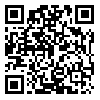BibTeX | RIS | EndNote | Medlars | ProCite | Reference Manager | RefWorks
Send citation to:
URL: http://jdisabilstud.org/article-1-2512-en.html
2- PhD in Counseling, Department of Psychology, Sari Branch, Islamic Azad University, Mazandaran Province, Iran
3- PhD in Psychology, Sari Branch, Islamic Azad University, Mazandaran Province, Iran
Abstract
Background & Objectives: Interpersonal communication for some people is an anxious part of their daily lives. Interpersonal problems are one of the factors that affect the psychological well–being of people. These problems include assertiveness and being sociable, openness in relationships, consideration for others, aggression, support and participation, and dependence are seen in most psychological disorders along with negative self–assessment of individuals. Social anxiety disorder is one of the most common mental disorders that causes many problems for patients by limiting their abilities. One of the interventions used to treat the problems of anxious people is cognitive behavior therapy. Cognitive–behavioral therapy is a method that has been used to treat a wide range of mental disorders and has received a lot of theoretical and experimental support. So, this study aimed to evaluate the effectiveness of cognitive behavioral therapy on interpersonal problems in women with social anxiety.
Methods: The method of the present study was quasi–experimental with a pretest–posttest with a 6–month follow–up design and a control group. The statistical population consisted of all female students of the Islamic Azad University of Islamshahr Branch in the academic year of 2017–2018, who had interpersonal problems. Thirty women students were selected by convenience sampling and were randomly divided into two equal experimental and control groups (each group with 15 persons). The experimental group received cognitive–behavioral therapy for six sessions, (90 minutes) and the control group received no treatment. The inclusion criteria were as follows: receiving social anxiety disorder without coexistence with other disorders, as the main diagnosis, according to the opinion of a clinical psychologist and based on the criteria of the Diagnostic and Statistical Manual of Mental Disorders, Fifth Edition (DSM–5), participating in the initial interview with a graded format of cognitive–behavioral therapy, not receiving psychological services outside of therapy sessions. The exclusion criteria were as follows: drug or alcohol abuse, receiving drug or any type of psychosocial treatment simultaneously (by asking the volunteers), leaving the treatment session, and not participating in the compensation or evaluation sessions. Research instruments included the Social Phobia Inventory (SPIN) (Connor et al. 2000) and the Interpersonal Problems Questionnaire (Barkham et al. 1996). After the program, both groups were assessed as a posttest. Next, after six months, the groups were assessed in a follow–up session. To analyze the data, descriptive and inferential methods were used. For descriptive statistics, we used mean and standard deviation and for inferential statistics, the repeated measures of analysis of variance. To evaluate the mean differences in the pretest and posttest time series and the follow–up period, we used the Bonferroni post hoc test. Data were analyzed with SPSS version 22 software. The significance level of the tests was considered 0.05.
Results: The results showed that the means and standard deviations for the variable of interpersonal problems in the experimental group and the control group in the pretest were 57.53±8.56 and 54.66±5.53, respectively. In the posttest, they were 35.33±14.14 and 54.06±8.81 respectively. Finally, in the follow–up, they were 37.53±4.89 and 57.26±5.76, respectively. In evaluating the effectiveness of cognitive–behavioral therapy for repetitive measures of analysis of variance, the group effect and the time effect on the variable of interpersonal problems were significant (p<0.001). The interaction effect of time and group was also significant on the average scores in three time points, between the experimental and control groups, and it reduced the interpersonal problems of the experimental group (p<0.001). Also, the average scores of the variable of interpersonal problems in the experimental group in the posttest and follow–up phases were significantly lower than the pretest (p<0.001). However, no significant difference was observed between the two stages of posttest and follow–up (p=0.712), which indicated the persistence of the effectiveness of cognitive–behavioral therapy in the follow–up stage.
Conclusion: Based on the findings of this study, cognitive–behavioral therapy intervention can be used as an effective therapeutic approach to reduce interpersonal problems in women students with social anxiety.
| Rights and permissions | |
 |
This work is licensed under a Creative Commons Attribution-NonCommercial 4.0 International License. |



